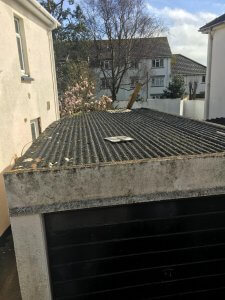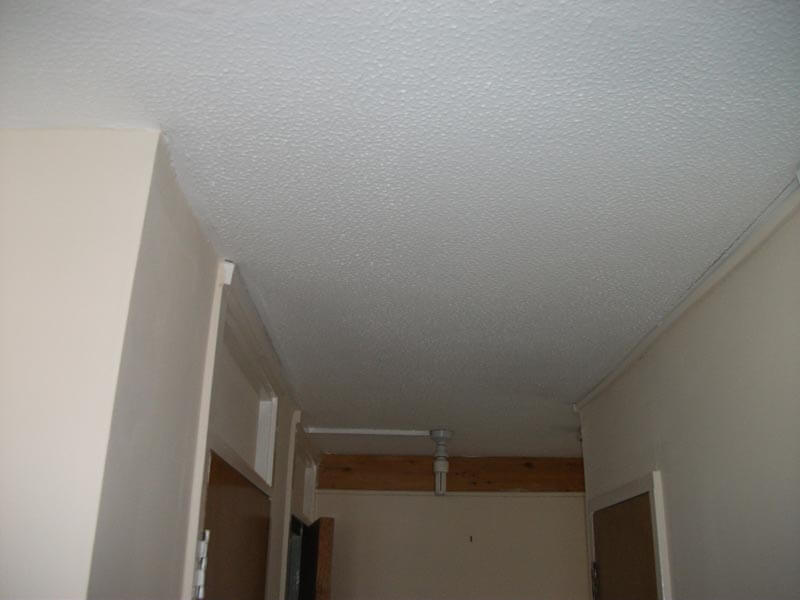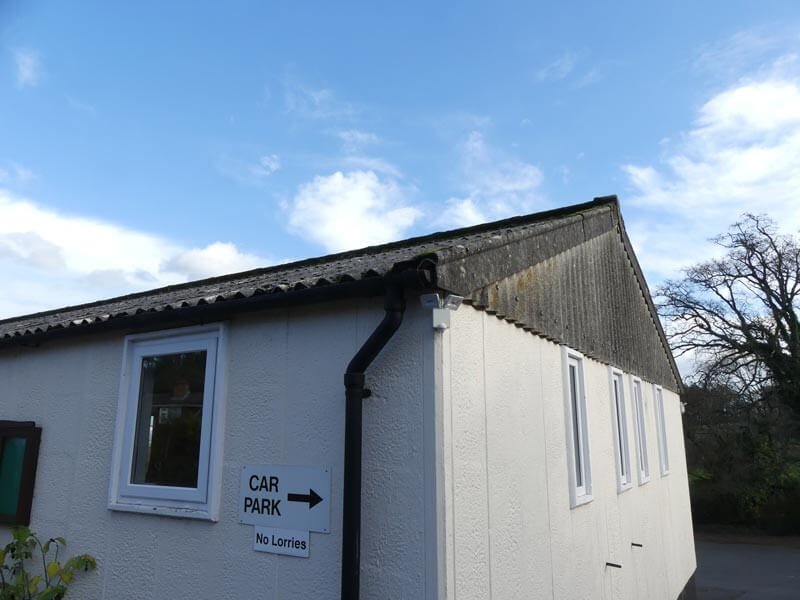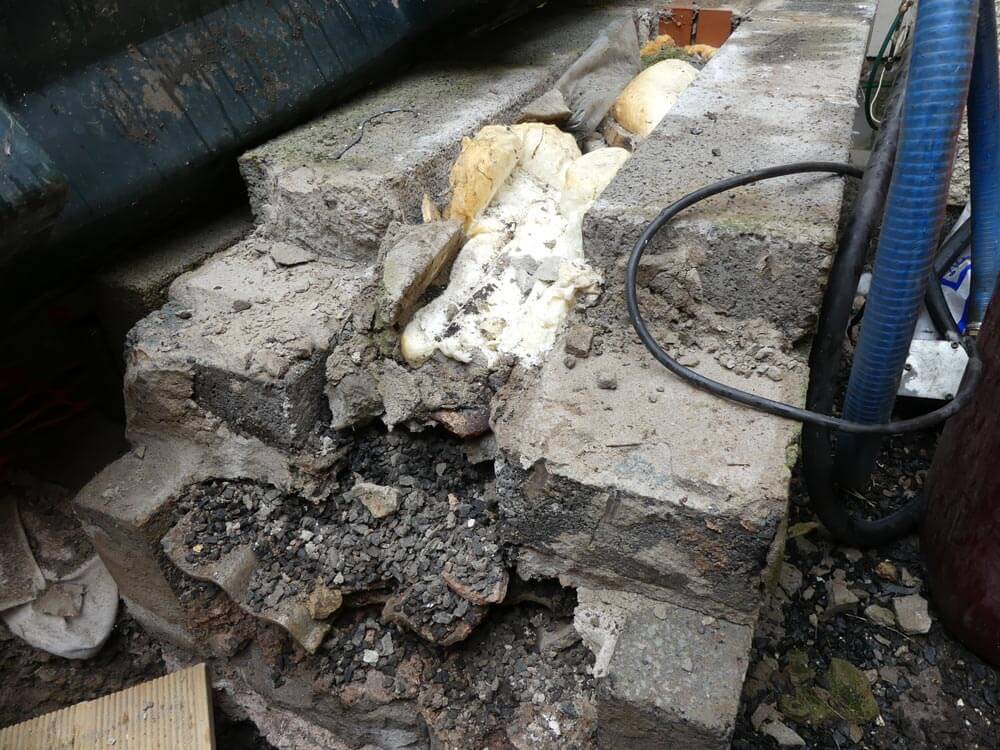Asbestos Removal
Asbestos has the potential to be a very dangerous substance and asbestos removal should only be attempted by trained professionals such who have the appropriate knowledge and safety equipment to carry out the removal safely.

Homeowners should generally not attempt asbestos removal themselves unless they are totally confident that the material they are working with has been properly identified (usually by means of surveying and sample analysis) and they are able to carry out the works in accordance with the current legislative guidance. If they suspect that their home contains any asbestos containing materials (ACMs) they should contact an experienced asbestos removal contractor who can then carry out an asbestos survey or sampling regime to ascertain the extent of the problem and the type of asbestos that is present.
Due to the inherent dangers associated with exposure to asbestos it is imperative that all guidelines are adhered to when removing asbestos.
Asbestos removal and abatement must be a carefully planned and controlled process. Initially an asbestos survey will allow the professionals to identify what it is they are dealing with and then to formulate a best course of action for the removal of an asbestos containing material.

Asbestos Removal – Safety First
By employing an asbestos professional to undertake an asbestos surveys and the abatement of asbestos you are ensuring that they will have all the necessary safety equipment and knowledge of what precautions to take to make the removal of asbestos as safe as possible. Asbestos removal requires the establishment of a controlled working environment and the selection of task specific safety equipment. This equipment helps to ensure that inhalation and contact with the dangerous asbestos particles is minimised and that the material can be removed and disposed of safely. Specialist equipment is utilised by asbestos removal professionals during asbestos surveys and abatement and is necessary to ensure that the works that are being undertaken are safe. If you are worried that your property contains asbestos materials, it is important that you don’t disturb the material as it is at its most dangerous when it’s broken or disturbed.
Asbestos Removal – Getting the Job Right
Once you have taken the decision to remove your asbestos containing materials it is important that you employ a suitably qualified professional company to ensure that all of the identified asbestos material is removed. Even a small exposure to asbestos fibres has the potential to be dangerous and it is important that professional asbestos surveyors and removal contractors are used to ensure that the asbestos materials are removed safely and the property is left in a clean and safe condition for reoccupation.

Abestos Removal Services
Click below to read more about our removal services.
Asbestos Garage Roofs
- Use correct RPE & PPE for the duration of works
- Clearly identify the work area and restrict access for the duration of works
- Type H vacuum may be required for cleaning
- Avoid or minimise breaking the corrugated roof sheeting
- If the sheets are bolted in place, dampen and cut the bolts while avoiding contact with the asbestos
- Carefully remove the asbestos roofing sheets
- Double wrap all sheets in 1000g polythene sheeting, seal with tape & label
- Any debris will need to be double bagged and sealed
- Disposal of all waste at a licensed landfill site
- Visual inspection of area by supervisor / hand back to client
The site risk assessment will be in place before the start of any work.
Asbestos cement products typically have a high density and contain levels of between 10 – 25% of predominantly chrysotile, although amosite and crocidolite have also been added in some instances. Fibre release from asbestos cement is unlikely provided the material is in good condition and not disturbed. Asbestos cement products can be found in the form of external corrugated rood panels or wall panels, door lining panels, under tile edging panels, soffit panels, panels above doors and fixed wall and ceiling panels.
Asbestos Textured Coating (Artex)
- Use correct RPE & PPE for the duration of works
- Type H vacuum will be required for cleaning
- Depending on the size of the area to be removed, it may be necessary to form an air tight enclosure with airlock for the duration of works
- Carefully remove the textured coating by suppressing and double bagging the waste immediately
- Clean the area using a type H vacuum
- Visual inspection of area by supervisor
- Disposal of all waste at a licensed landfill site. Depending on the size of the job / location, it may be prudent to have some air monitoring during / after the asbestos removal
The site risk assessment will be in place before the start of any work. Textured coating generally contain between 3 – 5% chrysotile. Due to the low asbestos content of these materials they are considered low risk and pose no significant risk to persons using the building provided they remain undisturbed. Textured coatings can be present on ceiling or walls also more commonly known as the brand name ‘Artex’.
Asbestos Floor Tiles
General Removal Methodology
- Use correct RPE & PPE for the duration of works
- Clearly identify the work area and restrict access for the duration of works
- Type H vacuum will be required for cleaning
- Depending on the size of the area to be removed, it may be necessary to form an air tight enclosure with airlock for the duration of works
- Carefully remove the asbestos floor tiles by suppressing and double bagging the waste immediately
- Clean the area using a type H vacuum
- Disposal of all waste at a licensed landfill site
- Depending on the size of the job / location, it may be prudent to have some air monitoring during / after the asbestos removal
- Visual inspection of area by supervisor / hand back to client
The site risk assessment will be in place before the start of any work.
Reinforced PVC and plastic composites usually contain between 1 – 10% chrysotile (white asbestos), although in toilet cisterns and window sills, amosite (brown asbestos) is more commonly used. Resin composite are usually reinforced with woven chrysotile cloth containing 20 – 50% asbestos. Fibre release is unlikely with these types of materials. They are considered low risk and pose no significant risk provided they remain undisturbed. Reinforced composites can be found as vinyl floor tiles, toilet cisterns, window sills and worktops.
Asbestos Roof Tiles
General Removal Methodology
- Use correct RPE & PPE for the duration of works
- Clearly identify the work area and restrict access for the duration of works
- Type H vacuum may be required for cleaning
- Avoid or minimise breaking the roof tiles
- If the roof tiles are nailed, carefully prise from fixing to minimise disturbance
- Double bag all roof tiles, seal with tape & label
- Any debris will need to be double bagged and sealed
- Disposal of all waste at a licensed landfill site
- Visual inspection of area by supervisor / hand back to client
The site risk assessment will be in place before the start of any work
Asbestos cement products typically have a high density and contain levels of between 10 – 25% of predominantly chrysotile, although amosite and crocidolite have also been added in some instances. Fibre release from asbestos cement is unlikely provided the material is in good condition and not disturbed. Asbestos cement products can be found in the form of external corrugated roof panels or wall panels, door lining panels, under tile edging panels, soffit panels, panels above doors and fixed wall and ceiling panels.
Asbestos Guttering / Downpipes
General Removal Methodology
- Use correct RPE & PPE for the duration of works
- Clearly identify the work area and restrict access for the duration of works
- Type H vacuum may be required for cleaning
- Avoid or minimise breaking the guttering / downpipes
- Cut the fixings while avoiding contact with the asbestos
- Carefully remove the asbestos guttering / downpipes
- Double wrap all asbestos in 1000g polythene sheeting, seal with tape & label
- Any debris will need to be double bagged and sealed
- Disposal of all waste at a licensed landfill site
- Visual inspection of area by supervisor / hand back to client
The site risk assessment will be in place before the start of any work
Asbestos cement products typically have a high density and contain levels of between 10 – 25% of predominantly chrysotile, although amosite and crocidolite have also been added in some instances. Fibre release from asbestos cement is unlikely provided the material is in good condition and not disturbed. Asbestos cement products can be found in the form of external corrugated roof panels or wall panels, door lining panels, under tile edging panels, soffit panels, panels above doors and fixed wall and ceiling panels.
Asbestos Ceilings / Wall Linings
General Removal Methodology
- Use correct RPE & PPE for the duration of works
- Clearly identify the work area and restrict access for the duration of works
- Type H vacuum will be required for cleaning
- Depending on the size of the area to be removed, it may be necessary to form an air tight enclosure with airlock for the duration of works
- Carefully remove the asbestos ceiling / wall linings by suppressing and double bagging the waste immediately
- Clean the area using a type H vacuum
- Disposal of all waste at a licensed landfill site
- Depending on the size of the job / location, it may be prudent to have some air monitoring during / after the asbestos removal
- Visual inspection of area by supervisor / hand back to client
The site risk assessment will be in place before the start of any work
Asbestos cement products typically have a high density and contain levels of between 10 – 25% of predominantly chrysotile, although amosite and crocidolite have also been added in some instances. Fibre release from asbestos cement is unlikely provided the material is in good condition and not disturbed. Asbestos cement products can be found in the form of external corrugated roof panels or wall panels, door lining panels, under tile edging panels, soffit panels, panels above doors and fixed wall and ceiling panels.
Asbestos insulation typically contain a substantial amount of asbestos fibres (up to 100%) with a very low density. Given this, airborne fibre concentration can be significantly high if the material is damaged or disturbed. Asbestos insulation products can be used for pipe lagging, boiler lagging and sprayed coatings on ceilings.
Asbestos Encapsulation
General Removal Methodology
- Use correct RPE & PPE for the duration of works
- Clearly identify the work area and restrict access for the duration of works
- Type H vacuum may be required for cleaning
- Apply co polymer mastic to damaged areas / use calico scrim / tape to seal all areas
- Fix asbestos identification labels
- Visual inspection of area by supervisor / hand back to client
The site risk assessment will be in place before the start of any work
Asbestos cement products typically have a high density and contain levels of between 10 – 25% of predominantly chrysotile, although amosite and crocidolite have also been added in some instances. Fibre release from asbestos cement is unlikely provided the material is in good condition and not disturbed. Asbestos cement products can be found in the form of external corrugated roof panels or wall panels, door lining panels, under tile edging panels, soffit panels, panels above doors and fixed wall and ceiling panels.
Asbestos Debris Cleaning (Environmental)
General Removal Methodology
- Use correct RPE & PPE for the duration of works
- Clearly identify the work area and restrict access for the duration of works
- Type H vacuum will be required for cleaning
- Depending on the size of the area to be cleaned, it may be necessary to form an air tight enclosure with airlock for the duration of works
- Carefully remove the asbestos debris by suppressing and double bagging the waste immediately
- Clean the area using a type H vacuum
- Disposal of all waste at a licensed landfill site
- Depending on the size of the job / location, it may be prudent to have some air monitoring during / after the asbestos removal
- Visual inspection of area by supervisor / hand back to client
The site risk assessment will be in place before the start of any work.
Asbestos cement products typically have a high density and contain levels of between 10 – 25% of predominantly chrysotile, although amosite and crocidolite have also been added in some instances. Fibre release from asbestos cement is unlikely provided the material is in good condition and not disturbed. Asbestos cement products can be found in the form of external corrugated roof panels or wall panels, door lining panels, under tile edging panels, soffit panels, panels above doors and fixed wall and ceiling panels.
Asbestos Hole Drilling
General Removal Methodology
- Use correct RPE & PPE for the duration of works
- Type H vacuum will be required
- Pre mark all areas that require drilling
- Protect nearby surface with 1000g polythene
- Use a low speed drill with attachment during the hole drilling process
- Seal the drilled edge with co polymer mastic
- Visual inspection of work by supervisor
- Disposal of any waste at a licensed landfill site
- Depending on the size of the job / location, it may be prudent to have some air monitoring during / after the asbestos removal
The site risk assessment will be in place before the start of any work
Textured coating generally contain between 3 – 5% chrysotile. Due to the low asbestos content of these materials they are considered low risk and pose no significant risk to persons using the building provided they remain undisturbed. Textured coatings can be present on ceiling or walls also more commonly known as the brand name ‘Artex’.
Asbestos cement products typically have a high density and contain levels of between 10 – 25% of predominantly chrysotile, although amosite and crocidolite have also been added in some instances. Fibre release from asbestos cement is unlikely provided the material is in good condition and not disturbed. Asbestos cement products can be found in the form of external corrugated roof panels or wall panels, door lining panels, under tile edging panels, soffit panels, panels above doors and fixed wall and ceiling panels.
Asbestos insulation typically contain a substantial amount of asbestos fibres (up to 100%) with a very low density. Given this, airborne fibre concentration can be significantly high if the material is damaged or disturbed. Asbestos insulation products can be used for pipe lagging, boiler lagging and sprayed coatings on ceilings.
Asbestos Soffit Removal
General Removal Methodology
- Use correct RPE & PPE for the duration of works
- Clearly identify the work area and restrict access for the duration of works
- Type H vacuum will be required for cleaning
- Depending on the size of the area to be removed, it may be necessary to form an air tight enclosure with airlock for the duration of works
- Carefully remove the asbestos soffit by suppressing and double bagging the waste immediately
- Clean the area using a type H vacuum
- Disposal of all waste at a licensed landfill site
- Depending on the size of the job / location, it may be prudent to have some air monitoring during / after the asbestos removal
- Visual inspection of area by supervisor / hand back to client
The site risk assessment will be in place before the start of any work
Asbestos cement products typically have a high density and contain levels of between 10 – 25% of predominantly chrysotile, although amosite and crocidolite have also been added in some instances. Fibre release from asbestos cement is unlikely provided the material is in good condition and not disturbed. Asbestos cement products can be found in the form of external corrugated roof panels or wall panels, door lining panels, under tile edging panels, soffit panels, panels above doors and fixed wall and ceiling panels.
Asbestos insulation typically contain a substantial amount of asbestos fibres (up to 100%) with a very low density. Given this, airborne fibre concentration can be significantly high if the material is damaged or disturbed. Asbestos insulation products can be used for pipe lagging, boiler lagging and sprayed coatings on ceilings.
Asbestos Waste Collections
General Removal Methodology
- Use correct RPE & PPE for the duration of works
- Clearly identify the work area and restrict access for the duration of works
- The asbestos will need to be double wrapped in 1000g polythene and correctly labelled.
- Disposal of all waste at a licensed landfill site
- Visual inspection of area by supervisor / hand back to client
The site risk assessment will be in place before the start of any work
Asbestos cement products typically have a high density and contain levels of between 10 – 25% of predominantly chrysotile, although amosite and crocidolite have also been added in some instances. Fibre release from asbestos cement is unlikely provided the material is in good condition and not disturbed. Asbestos cement products can be found in the form of external corrugated roof panels or wall panels, door lining panels, under tile edging panels, soffit panels, panels above doors and fixed wall and ceiling panels.











